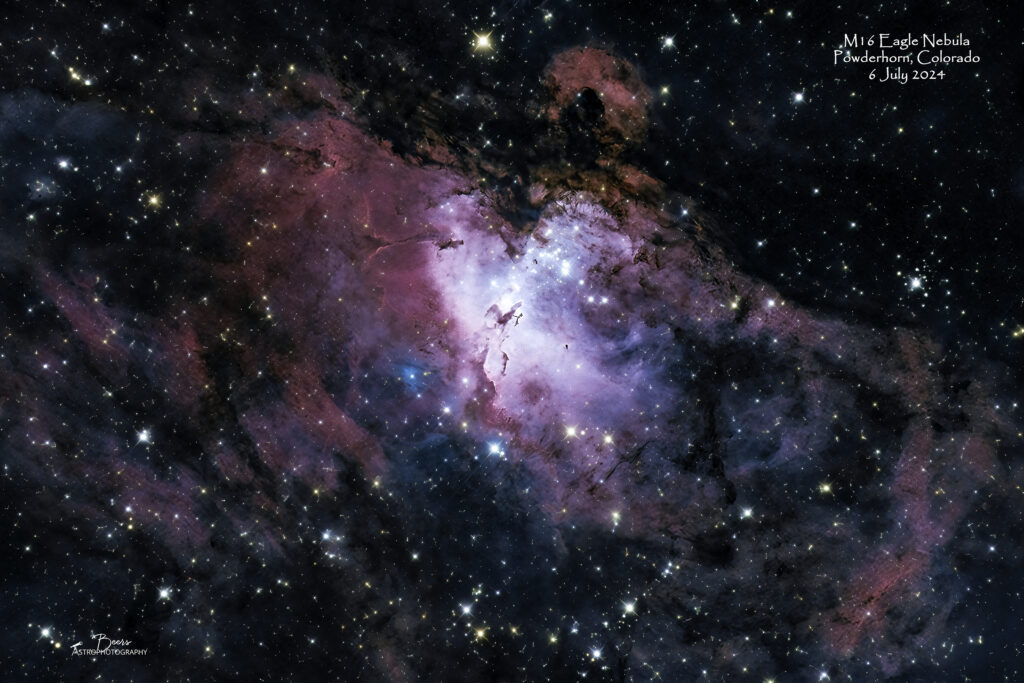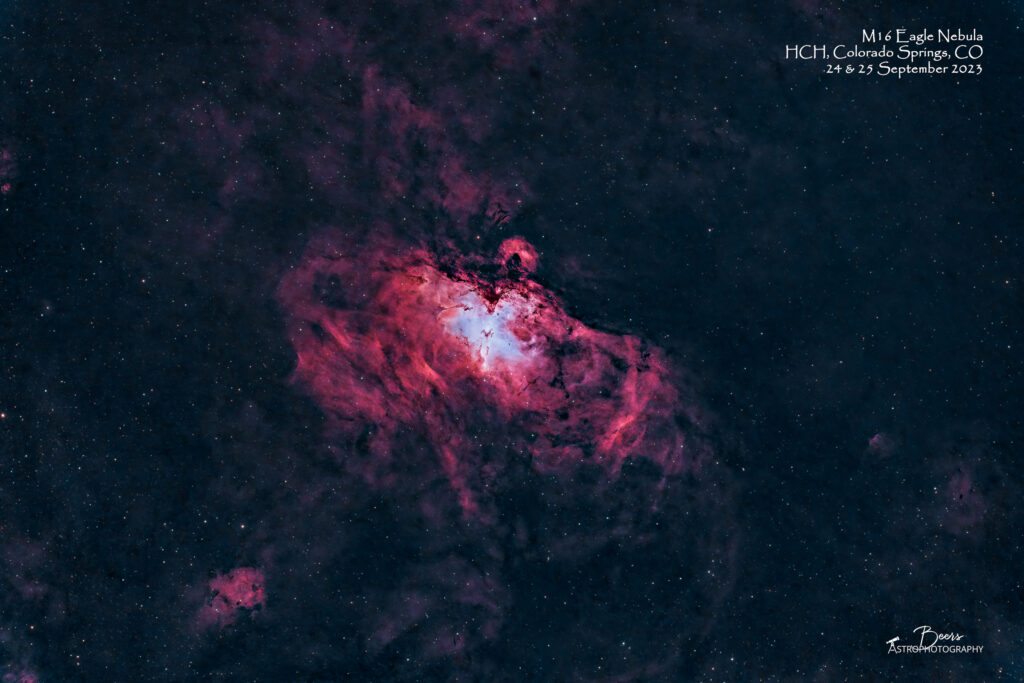
Fun facts
M16 Eagle Nebula (also known as the Star Queen Nebula) is a young open cluster of stars in the constellation Serpens, discovered by Jean-Philippe de Cheseaux in 1745–46. Both the “Eagle” and the “Star Queen” refer to visual impressions of the dark silhouette near the center of the nebula, an area made famous as the “Pillars of Creation” imaged by the Hubble Space Telescope. The nebula contains several active star-forming gas and dust regions, including the aforementioned Pillars of Creation. The Eagle Nebula lies in the Sagittarius Arm of the Milky Way.
M16 Eagle Nebula is part of a diffuse emission nebula, or H II region, which is catalogued as IC 4703. This region of active current star formation is about 5700 light-years distant. A spire of gas that can be seen coming off the nebula in the northeastern part is approximately 9.5 light-years or about 90 trillion kilometers long.
The cluster associated with the nebula has approximately 8100 stars, which are mostly concentrated in a gap in the molecular cloud to the north-west of the Pillars. The brightest star (HD 168076) has an apparent magnitude of +8.24, easily visible with good binoculars. This star has a mass of roughly 80 solar masses, and a luminosity up to 1 million times that of the Sun. The cluster’s age has been estimated to be 1–2 million years.
The descriptive names reflect impressions of the shape of the central pillar rising from the southeast into the central luminous area. The name “Star Queen Nebula” was introduced by Robert Burnham, Jr., reflecting his characterization of the central pillar as the Star Queen shown in silhouette.
Other Catalog Designations: Eagle Nebula, Star Queen Nebula, M16, NGC6611, IC4703, SH2-49, RCW165, LBN67, Cr375, Mel198, Ced159
Subtype: HII region, Cluster associated with nebulosity
Magnitude: 6.0
Distance from Earth: 7000 light years
Size (apparent dimensions): 2° x 25’
Constellation: Serpens
{ From: https://en.wikipedia.org/wiki/Eagle_Nebula and Stellarium}
Capture Notes
On Saturday morning in the Beast, after finishing the stacking, before turning off the SC laptop, I did the target selection for Saturday night (6Jul2024) from my list. The two targets I had left uncollected were the M16 Eagle Nebula and NGC6888 Crescent Nebula. I could have split the night between the two, but decided that NGC6888 would be better collected with Big Zeus (because of its size) and was predominantly red, so wouldn’t suffer from collection on the front patio. So, I decided to spend the full night imaging M16 Eagle Nebula (the second of the targets that Matt Dettrick would have had me traveling to Chile to image!)
During the day on Saturday, I decided to disassemble and put away the autofocusers before the last night of imaging both to facilitate the early morning departure and because they had not working correctly throughout the trip anyway. I’d read the SGP EAF instructions for doing a ~20 minute test (with the caveat that you needed patience!) and decided that I would do the suggested test to figure out the optimal step size (suggested that should use 9 steps unless you “have a reason not to”) when I am not burning dark skies time.
Sequence Plan (6Jul2024): Gain: 158, Temp: -0°C, offset=30. 72x5min. Captured 6Jul2024, 2154 – 7Jul2024, 0417MDT. Total exposure time: 6:00hrs (360min, ASI2400-BB)
Equipment
Equipment: All equipment controlled by HP Probook running Sequence Generator Pro v4.4.0.1339.
- Imaging (ASI2400-BB): ZWO ASI2400MC imaging camera on (Big Bertha) Orion 8″ f/8 Ritchey-Chretien Astrograph Telescope
- Autofocuser: ZWO EAF Electronic Automatic Focuser – Standard (EAF-5V-STD) (Did not use autofocuser. Disassembled before last night of imaging to facilitate early morning departure on Sunday. Wasn’t working correctly with BB anyway.)
- Mount: Rainbow Astro RST-300 (controlled by iHubo ASCOM driver)
- Polar alignment: QHYCCD camera (controlled by Polemaster for polar alignment)
- Autoguiding: Orion 60mm Multi-Use Guide Scope with Orion StarShoot AutoGuider Pro Mono Astrophotography Camera (controlled by PHD2)
Summary
Captured: 6 July 2024, 360 minutes, 6:00hrs
Shooting location: BLM land near Powderhorn, Colorado
Equipment: Big Bertha on Rainbow Astro RST-300
Processing summary: Captured in SGP, stacked in APP (Adaptive Airy), star removal with Starnet++, processing with LR/PS
Additional Images of M16 Eagle Nebula

Capture Notes
Beginning on Sunday, 24 September 2023 we had a week of clear skies at home (with the moon building to the full Harvest Supermoon on Friday, 29Sep2023). I had finally convinced Orion that I REALLY did need the extension tube for Big Bertha and they relented to sell it (I preferred 2×1” tubes, but all they had in stock was the 2” tube) to me. I ordered on it Friday, 22 September and it was to be shipped on Monday. So, I decided to use the Southern Cross while I waited for the missing piece to make ASI2400-BB whole. Although I was past prime viewing time (in late spring and early summer), with a bit of passive aggressive streak (still hanging on to the annoyance that a workshop organizer was going to have me traveling all the way to Chile to photograph M16 Eagle Nebula), I decided to start the evening(s) imaging the M16 Eagle Nebula until it set at approximately 2300MDT. Both night’s capture went well, with the target being well past the meridian when I started and setting in the southwest, I could let it go past the point of the house’s 20° horizon.
Equipment
Polar alignment: QHYCCD camera (controlled by Polemaster)
Imaging stream: (Southern Cross) Askar FRA600 on Rainbow Astro RC-135E, ZWO ASI2400MC#1 camera, Optolong LeXtreme light pollution filter
Mount: Rainbow Astro RC-135E (controlled by iHubo ASCOM driver)
Autoguider: Orion 60mm Multi-Use Guide Scope, Orion StarShoot AutoGuider Pro Mono Astrophotography Camera (controlled by PHD2)
Equipment controlled by HP Probook (DSO CTRL 1) running Sequence Generator Pro v3.2.0.660.
Capture & processing notes
Sequence plans:
24Sep2023: Gain: 158, Temp: -0°C, offset=NotSet, Bin: 1×1, 30x5min. Captured 24Sep2023, 2013 – 2248MDT. Total exposure time: 2:30hrs.
25Sep2023: Gain: 158, Temp: -0°C, offset=NotSet, Bin: 1×1, 34x5min. Captured 25Sep2023, 1959 – 2256MDT. Total exposure time: 2:50hrs.
Shooting location: HCH, Colorado Springs, CO
Processing summary: Captured with SGP. Stacked in APP (HaOIII Color, Extract Ha, Extract OIII). Star removal with Starnet++. Processed in LR/PS. It turned out that this processing was a hybrid between my “standard” process using AW presets to bring out colors/hues and Nico Carver’s colorizing the Ha and OIII images. After getting the overall image to the point that I liked the overall color/hue, I was still dissatisfied with the “chest” of the eagle being so white vs. showing some of the blues. So, I used the HaOIII extract OIII STARLESS layer to create a colorized (blue) layer that I “painted in” to the image.

Capture Notes
After the thunderstorms passed through, the skies cleared (mostly) to allow shooting with RaBZ. Since the moon was at 90% illumination, decided to use the LeXtreme filter and shoot M16 Eagle Nebula, which is small enough to fit into a single frame of Big Zeus and is mostly red (i.e., not missing other “colors” with the narrowband filter).
Equipment
Polar alignment: QHYCCD camera (controlled by Polemaster)
Imaging stream: Orion 10″ f/8 Ritchey-Chretien Astrograph Telescope, Canon EOS Ra with Optolong L-eXtreme LP filter
Mount: Sky-Watcher EQ6-R Pro Equatorial Mount (controlled by EQMOD)
Autoguider: Orion 60mm Multi-Use Guide Scope, Orion StarShoot AutoGuider Pro Mono Astrophotography Camera (controlled by PHD2)
Equipment controlled by HP Probook (DSO CTRL 1) running Sequence Generator Pro v3.2.0.660.
Capture & processing notes
Sequence plan: ISO1600; 35x300sec; captured 16Jul2022, 2309MDT – 17Jul2022, 0301. Total exposure time: 2:55hrs.
Capture: 16 July 2022
Shooting location: Colorado Springs, Colorado
Processing: Stacked in APP, processed in LR/PS.
